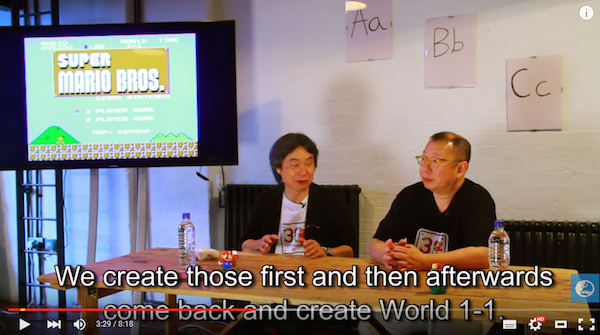
Ahead of the launch of Mario-themed level-building game Super Mario Maker, video game industry legend Shigeru Miyamoto sat down with veteran game designer Takashi Tezuka to take questions from journalists and show off its features.
Before leaping into the level creation proper, however, Miyamoto took a few minutes to talk about the creative process that is involved in building a Super Mario level, talking his audience through the steps he and his team took when creating the original Super Mario Bros., and explaining why World 1-1 of the game—for many their first ever brush with Mario on Nintendo’s 8-bit system—was built the way it is.
You’ve no doubt cleared this level countless times by now, but you may not have realised the hidden genius and careful planning that went into the positioning of every block, pipe, and pit of doom.
“Show, don’t tell,” my professor would tell me when critiquing my creative writing work back in my university days. “Let the reader discover without having everything explained to them.”
The same principle, it turns out, is applied to the best video game levels.
World 1-1 of Super Mario Bros. will be instantly recognisable to pretty much anyone who grew up in Japan or the western world in the 1980s and early 90s, and perhaps even to a few of those who experienced the game as a digital download for one of Nintendo’s more recent consoles. The original NES Super Mario Bros. did of course come with a printed instruction manual tucked in its box, but the majority of players—this writer included—were so eager to get started that they rarely even glanced at its pages before firing the game up. How, then, did game designer Miyamoto and his team explain the game’s rules to the player while ensuring that the learning process was both gradual and intuitive as well as being fun? You might be surprised:
Huh. Who knew?
▼They chose a mushroom as a power-up item because they figured the idea of a ‘suspicious mushroom’ would be understood all around the world…
▼ Coins hidden in blocks were an easy way to reinforce the action of jumping to hit them…
▼ New players will try to jump over the first power-up mushroom, mistaking it for another enemy. Thanks to the positioning of the blocks overhead, however, they’ll almost always touch the mushroom, grow bigger, and then realise it’s a power-up.
▼ A programmer once referred to the original design of a Goomba as a kuri (chestnut), giving rise to the Japanese name for the character, which has stuck until this day.
▼ Oh, and that seemingly random hole with nothing in it midway through the level…
▼ …was a subtle way of preparing the player for what was to come.
Remember, folks: show, don’t tell.
Good luck with your own level designing if you’re picking up Super Mario Maker at the end of the week! By all means leave your level codes in the comments section below so we can play them too!
Thanks to Eurogamer for putting this great video together.
Source & screenshots: YouTube/Eurogamer